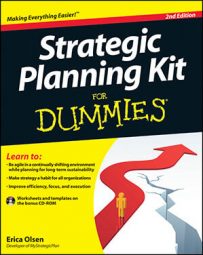Because strategic planning is about improving the status quo, looking at how to improve operations is the key. Operations produce and deliver the goods and services to customers. These processes encompass managing your creation of customer value. Service companies may be tempted to think that processes aren’t managed in this area, but consider how you deliver your service. It doesn’t happen by magic. You take specific steps to deliver what you do; these steps are your operational processes.
Operations management covers four generic processes:
Developing and sustaining supplier or vendor relationships: Bringing raw material and goods into your company is a set of processes that feed into how you produce products and services. Do you effectively manage your supplier relationships to ensure that you obtain the total lowest cost of the products and services you buy? Are you efficiently sourcing, moving, storing, and inspecting the raw materials you use?
Producing products and services: At the heart of your operational processes is the production of your product and service. Are you efficient at production, thereby lowering production costs and increasing your asset utilization? Are you effectively producing your product with minimal scrap, error rates, or returns?
Delivering the product or service to your customer: Just like with managing your suppliers, you also have processes that manage your distribution. Are you efficiently delivering your products or services to your customers? Are you effective at reaching your customers through your distribution channels?
Managing operating risk: Not all companies have direct operating risk, but most companies are exposed to some kind of risk associated with market fluctuations. Processes in this area deal with effectively and efficiently reducing costs associated with capital costs and taxes.
Erlach Computer Consulting, a small technology service company, improved the one key operational process that nearly doubled the company’s revenue in one year. The process? Time tracking. Yes, the process may sound simple, but for Erlach, time is the company’s inventory, product, and distribution medium. Starting from the top, management required every employee to track his or her time down to 15-minute increments.
The company was tracking time previously, but not with 100 percent compliance. Now that the time is captured, Erlach can account and bill for previously unbilled time. Not only were the employees more conscious of their work day, but also clients were correctly charged for the services they received.

